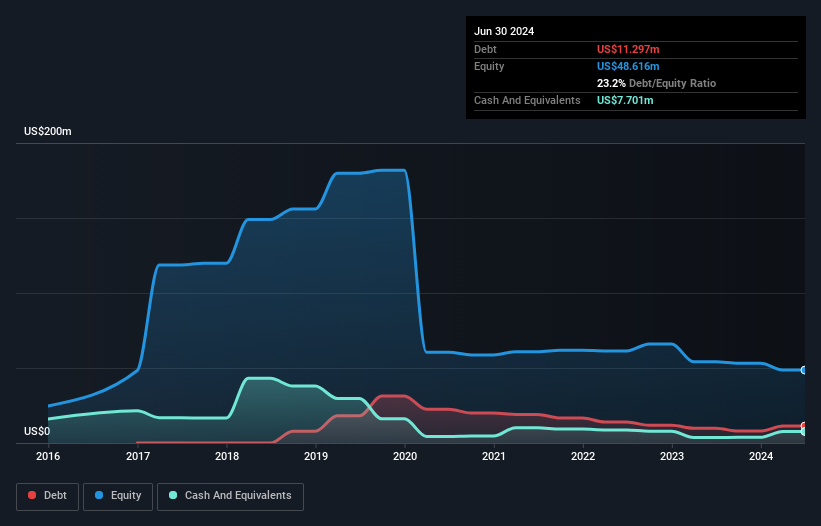
Some say volatility, rather than debt, is the best way to think about risk as an investor, but Warren Buffett famously said that 'Volatility is far from synonymous with risk.' When we think about how risky a company is, we always like to look at its use of debt, since debt overload can lead to ruin. We can see that Australis Oil & Gas Limited (ASX:ATS) does use debt in its business. But should shareholders be worried about its use of debt?
Why Does Debt Bring Risk?
Debt is a tool to help businesses grow, but if a business is incapable of paying off its lenders, then it exists at their mercy. In the worst case scenario, a company can go bankrupt if it cannot pay its creditors. However, a more common (but still painful) scenario is that it has to raise new equity capital at a low price, thus permanently diluting shareholders. Of course, debt can be an important tool in businesses, particularly capital heavy businesses. The first step when considering a company's debt levels is to consider its cash and debt together.
View our latest analysis for Australis Oil & Gas
What Is Australis Oil & Gas's Net Debt?
As you can see below, at the end of June 2024, Australis Oil & Gas had US$11.3m of debt, up from US$9.90m a year ago. Click the image for more detail. However, it does have US$7.70m in cash offsetting this, leading to net debt of about US$3.60m.

How Healthy Is Australis Oil & Gas' Balance Sheet?
The latest balance sheet data shows that Australis Oil & Gas had liabilities of US$12.2m due within a year, and liabilities of US$9.56m falling due after that. On the other hand, it had cash of US$7.70m and US$2.61m worth of receivables due within a year. So it has liabilities totalling US$11.4m more than its cash and near-term receivables, combined.
When you consider that this deficiency exceeds the company's US$7.78m market capitalization, you might well be inclined to review the balance sheet intently. In the scenario where the company had to clean up its balance sheet quickly, it seems likely shareholders would suffer extensive dilution. The balance sheet is clearly the area to focus on when you are analysing debt. But it is Australis Oil & Gas's earnings that will influence how the balance sheet holds up in the future. So if you're keen to discover more about its earnings, it might be worth checking out this graph of its long term earnings trend.
Over 12 months, Australis Oil & Gas made a loss at the EBIT level, and saw its revenue drop to US$19m, which is a fall of 17%. That's not what we would hope to see.
Caveat Emptor
While Australis Oil & Gas's falling revenue is about as heartwarming as a wet blanket, arguably its earnings before interest and tax (EBIT) loss is even less appealing. Its EBIT loss was a whopping US$4.8m. When we look at that alongside the significant liabilities, we're not particularly confident about the company. It would need to improve its operations quickly for us to be interested in it. It's fair to say the loss of US$5.6m didn't encourage us either; we'd like to see a profit. And until that time we think this is a risky stock. There's no doubt that we learn most about debt from the balance sheet. But ultimately, every company can contain risks that exist outside of the balance sheet. For instance, we've identified 3 warning signs for Australis Oil & Gas (1 makes us a bit uncomfortable) you should be aware of.
Of course, if you're the type of investor who prefers buying stocks without the burden of debt, then don't hesitate to discover our exclusive list of net cash growth stocks, today.
New: Manage All Your Stock Portfolios in One Place
We've created the ultimate portfolio companion for stock investors, and it's free.
• Connect an unlimited number of Portfolios and see your total in one currency
• Be alerted to new Warning Signs or Risks via email or mobile
• Track the Fair Value of your stocks
Have feedback on this article? Concerned about the content? Get in touch with us directly. Alternatively, email editorial-team (at) simplywallst.com.
This article by Simply Wall St is general in nature. We provide commentary based on historical data and analyst forecasts only using an unbiased methodology and our articles are not intended to be financial advice. It does not constitute a recommendation to buy or sell any stock, and does not take account of your objectives, or your financial situation. We aim to bring you long-term focused analysis driven by fundamental data. Note that our analysis may not factor in the latest price-sensitive company announcements or qualitative material. Simply Wall St has no position in any stocks mentioned.
About ASX:ATS
Australis Oil & Gas
An upstream oil and gas company, engages in the exploration, development, and production of oil and gas assets.
Good value with adequate balance sheet.


